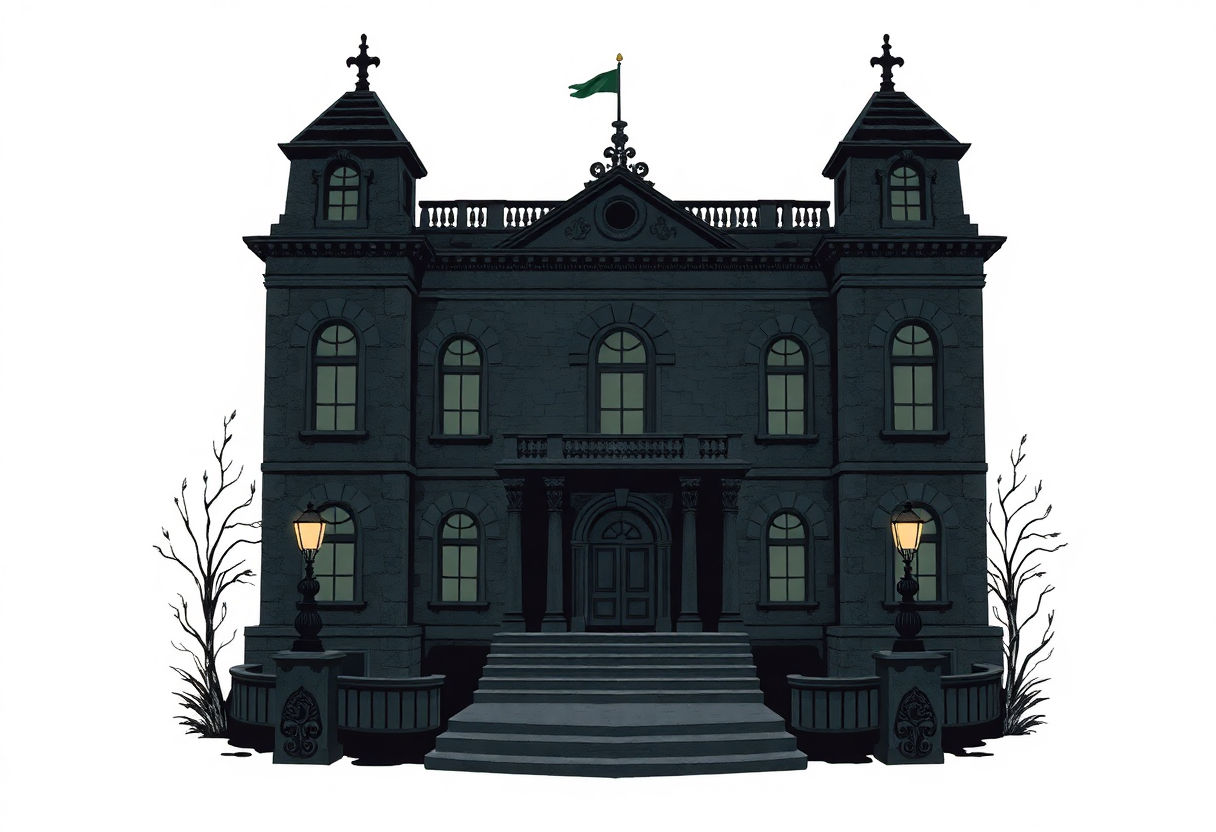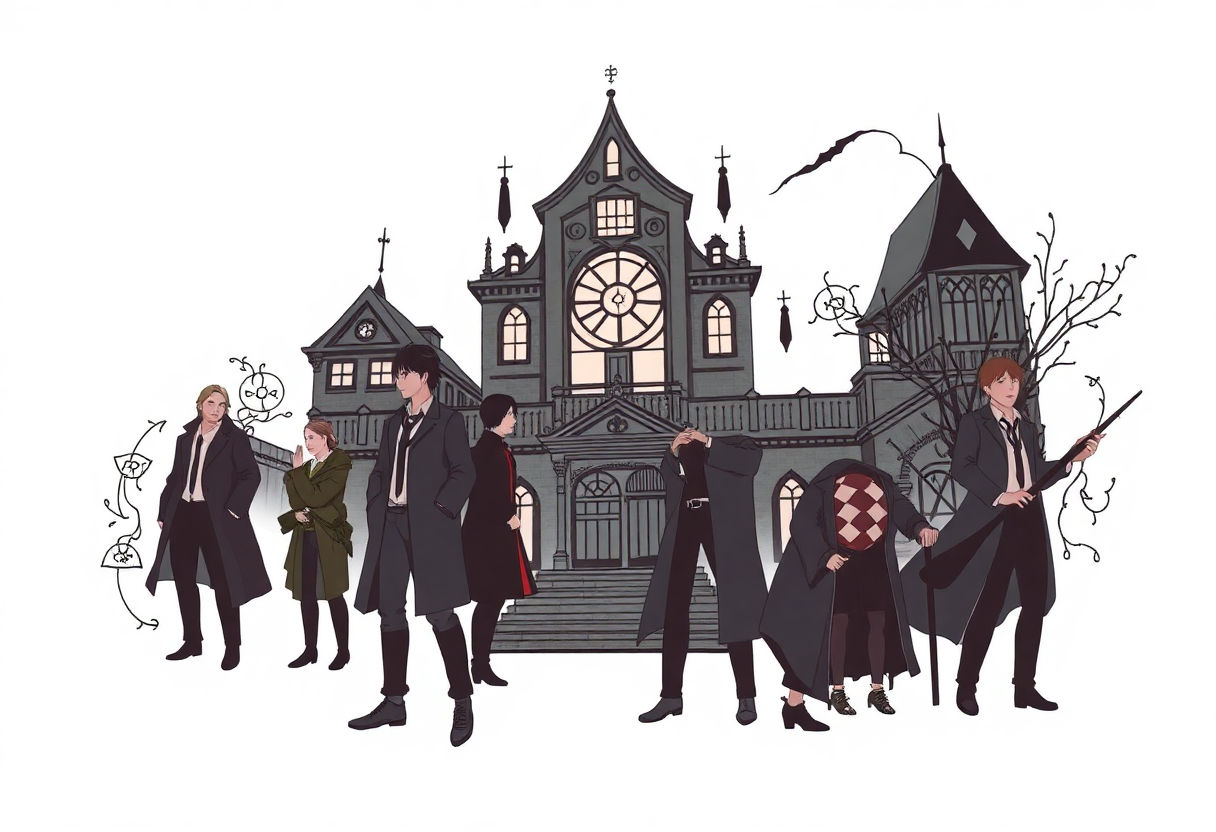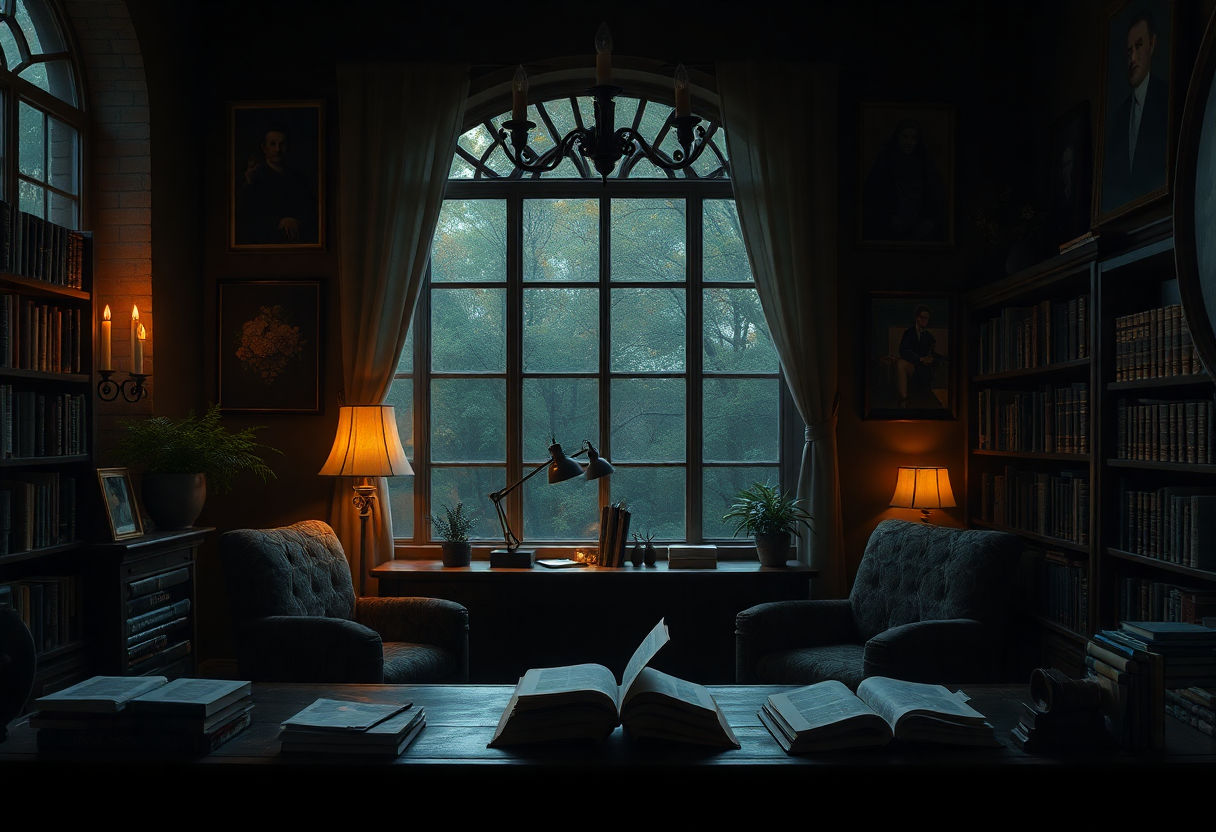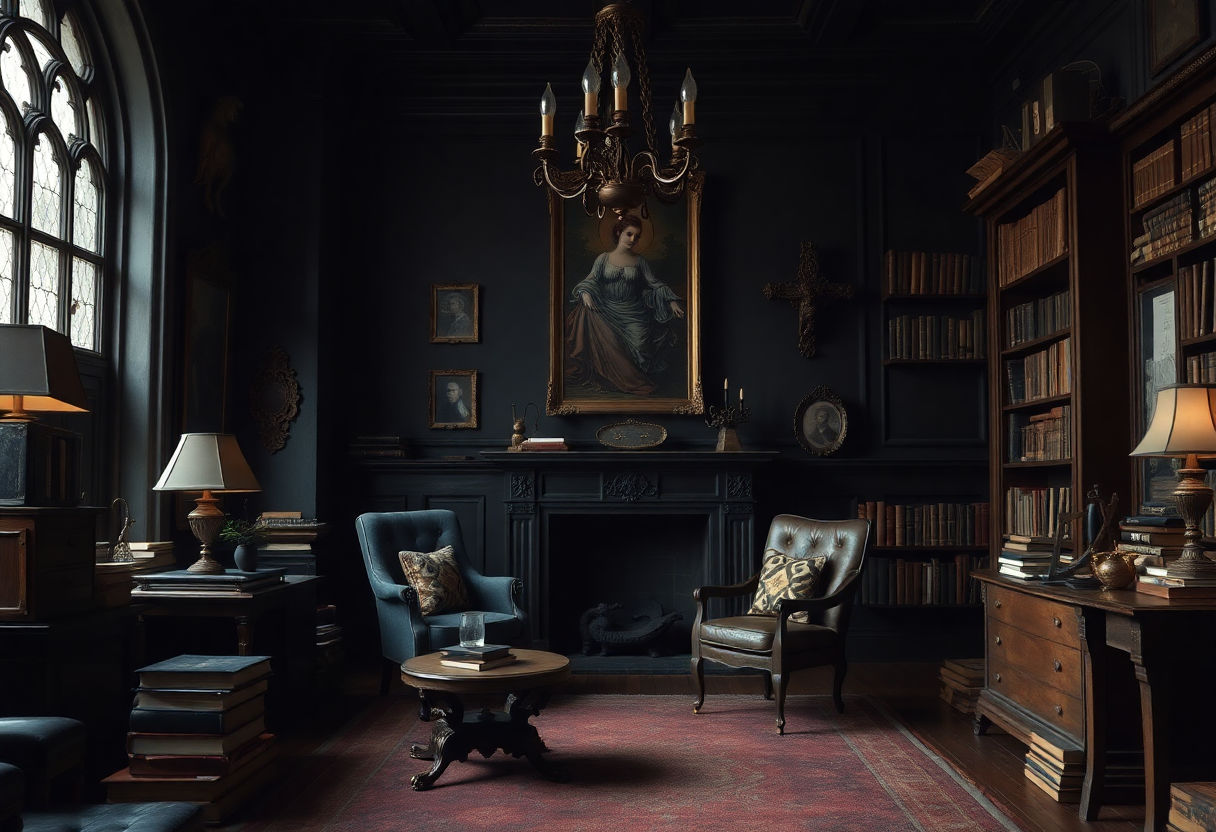The dark academia aesthetic, a mesmerizing blend of intellectual curiosity and vintage allure, has emerged as a sophisticated design trend captivating modern interior decor. This aesthetic draws inspiration from classical education and Gothic architecture, infusing spaces with deep color palettes, rich textures, and a profound appreciation for literature and art. As you delve into the core elements of dark academia, discover how traditional influences converge with modern adaptations to create uniquely personal interiors. Explore how strategically selected furniture, decor, and lighting transform any space into a cozy, moody haven that mirrors the timeless charm of scholarly pursuits and artistic expression.
Key Takeaways
- Dark academia designs blend historical influences with modern aesthetics, creating a timeless and sophisticated style in interior decor.
- Key components include deep color palettes, rich textures, and an emphasis on vintage and classic materials.
- Literature and art play a crucial role, enhancing the intellectual allure of the dark academia aesthetic.
- Thoughtful selection of furniture and decor contributes to the authentic look, while effective lighting techniques enhance the desired ambiance.
- Modern adaptations allow contemporary interiors to embrace dark academia without sacrificing their modern appeal, encouraging personalized touches for a unique experience.
Historical Influences

The dark academia aesthetic is deeply rooted in historical and cultural narratives that evoke a sense of nostalgia for classical education and intellectual pursuit. Its origins can be traced back to the romanticized perception of the elite institutions of the 19th and early 20th centuries, where the quest for knowledge was both an intellectual and an aesthetic pursuit. The aesthetic borrows heavily from the architectural and artistic styles of the European Renaissance and Victorian eras, periods known for their profound appreciation for the arts, humanities, and scholarly endeavors.
During the Renaissance, education and the arts were held in high esteem, with a focus on classical studies that is mirrored today in the dark academia movement. The rediscovery of Greco-Roman philosophy and literature during this period laid the groundwork for the aesthetic’s intellectual foundation. Additionally, the Victorian era’s fascination with gothic architecture, characterized by its dramatic arches and intricate stonework, has influenced the current dark academia aesthetic’s preference for grand, historically rich designs.
Moreover, the literature of the late 18th and 19th centuries plays a pivotal role in the dark academia theme. Works by the likes of Edgar Allan Poe, Mary Shelley, and the Brontë sisters inspire the moody, introspective atmosphere that defines much of the aesthetic’s allure. The period’s iconography—dimly lit libraries, musty old books, and rich mahogany wood—further enhances the sense of grandeur and depth that is central to the dark academia design. In essence, dark academia serves as an homage to these historical influences, inviting contemporary audiences to step back in time and immerse themselves in a world where learning and aesthetic pleasure are seamlessly intertwined.
Core Elements of Dark Academia

Dark academia designs are characterized by a moodiness and scholarly elegance that draws from a rich tapestry of elements, prominently featuring color palettes, textures, and materials. This aesthetic leans heavily on darker tones to evoke a sense of intellectual mystique and introspection.
Color Palettes and Textures
Central to dark academia is its use of deeply saturated hues that create a sophisticated and timeless atmosphere. Rich colors such as deep greens, burgundies, and charcoal grays dominate the palette. These colors are not merely about darkness but also about creating depth and contrast that invite a sense of thoughtful solitude and reflection.
Textures play a crucial role in enhancing the visual and tactile experience of a space. Think weathered wood, aged leather, and heavy, lush fabrics like velvet and wool. These materials contribute to the warm, inviting feel of a place that seems steeped in history and learning. The interplay between these textures and colors is essential, creating layers of visual interest akin to the pages of a well-loved book.
The thoughtful use of textures and colors is designed to echo the cloistered halls of ancient libraries and universities. This invokes an environment that encourages intellectual pursuits and philosophical contemplation, providing the perfect backdrop for a life inspired by academia’s mysteries and disciplines.
In conclusion, dark academia artistry is more than just an aesthetic; it captures the essence of a bygone era’s scholarly charm. Through a meticulous arrangement of colors and textures, it crafts spaces that are both captivating and conducive to deep thought and reflection.
Incorporating Literature and Art

Incorporating literature and art into dark academia designs is a distinctive and compelling approach that enhances the intellectual depth and visual intrigue of a space. This aesthetic thrives on the notion that books and art are not merely accessories but foundational elements that define the environment.
Books as Focal Points
At the heart of dark academia lies a profound appreciation for literature. An elegant, well-organized library or a curated bookshelf can serve as the centerpiece of the room. Invest in leather-bound volumes and antique bookends to convey a sense of history and timelessness. Stacks of classics, entwined with contemporary literary works, foster an atmosphere that bridges past and present.
Artwork and Wall Decor
Art in dark academia is characterized by its embrace of classicism and romanticism. Oil paintings, particularly those showcasing dramatic scenes or portraits, complement the dark hues of the design. Frames with a vintage finish enhance the allure, drawing viewers into a story-rich visual experience. Consider adding landscapes or sketches reminiscent of university life, which echo the scholarly themes intrinsic to this style.
Integration of Calligraphy and Manuscripts
Displaying calligraphy pieces or framed manuscripts adds an elegant touch that accentuates the pursuit of knowledge and the value of the written word. These elements not only serve as conversation starters but also as daily reminders of the academic aspirations linked to the aesthetic.
Through these thoughtful incorporations, literature and art transform from mere adornments to integral components that enrich the ambiance and allure of a dark academia space.
Furniture and Decor Ideas
When seeking furniture and decor to evoke the dark academia aesthetic, it is essential to choose pieces that reflect a sense of history and intellectual charm. Rich wood furnishings such as mahogany or walnut bookcases are staples. These serve not only as functional storage but also as a tribute to classical elegance.
In terms of seating, plush armchairs upholstered in deep, luxurious fabrics like velvet or leather contribute to a cozy, inviting atmosphere. The inclusion of a Victorian-style desk can further enhance the scholarly ambiance, offering a distinguished space for reading and writing.
Adorn your walls with vintage prints, maps, and portraits that echo the aesthetic of old-world sophistication. Look for frame styles that are ornate and made of dark, aged metals or woods, as these details can significantly contribute to the mystique of the space.
To complement the main furniture pieces, select decorative items with a strong artistic and literary influence. Busts of classic authors, antique globes, and gilded mirrors are excellent choices. Consider incorporating brass accents through candlesticks or small sculptures for an added touch of period richness.
Moreover, textiles play a vital role in achieving the desired mood. Layering patterns such as tartan throws, oriental rugs, and vintage tapestries can provide depth, while maintaining the focus on subtle, romantic nuances. To accentuate the aesthetic further, include botanical elements like dried flowers or ivy, which can bring an element of natural beauty and timelessness to the room.
Overall, combining these thoughtful furniture choices and decor elements will create an inviting, intellectual space that embodies the essence of dark academia.
Lighting and Ambiance
Achieving the quintessential dark academia aesthetic relies heavily on creating the right lighting and ambiance. The interplay of light and shadow is crucial in setting a moody and inviting atmosphere that is characteristic of this design style.
To begin with, opting for low-key lighting is essential. This can be accomplished through the use of vintage sconces and table lamps, which not only emit a gentle, warm glow but also contribute to the overall historical vibe. When considering lamp shades, choose materials with deep hues or classic patterns. Dark wood or brass bases further enhance the scholarly feel.
Candlelight also plays a vital role in capturing the essence of dark academia. Placing candles in wrought-iron holders or ornate candelabras can accentuate architectural details while adding a touch of romanticism. For safety and convenience, LED candles can replicate the flickering softness of real flames without the risk.
Natural lighting should be carefully mediated with heavy curtains or drapes in rich fabrics like velvet or wool. These not only provide a sense of warmth but also allow control over the light that filters into the space. Heavy drapery also encourages the creation of cozy reading nooks, perfect for enjoying classic literature.
In addition, consider incorporating layered lighting, which allows for adjustable illumination that suits various moods and activities. Dimmers are particularly effective in achieving this flexibility. Together, these lighting strategies work harmoniously to produce an opulent and serene atmosphere that invites introspection and intellectual pursuit.
Modern Influence and Adaptations

Integrating dark academia designs into contemporary homes requires a delicate balance between maintaining the aesthetic’s historic charm and ensuring modern functionality. This nuanced approach begins with the infusion of traditional elements such as vintage furniture pieces, which can be elegantly paired with sleek, minimalist fixtures that echo contemporary sophistication.
Achieving harmony between the old and new can be seen in the juxtaposition of rich mahogany tables alongside modern glass or metal accents. These combinations allow for a seamless blend that respects the essence of dark academia while adapting it to current design trends.
Modern technology can play a transformative role in updating dark academia spaces. Innovative lighting solutions, such as LED-integrated bookcases or adjustable smart light systems, can enhance the ambient mood while promoting energy efficiency. The use of technology enhances not only the visual appeal but also the functional aspect of these spaces.
Incorporating dark academia into everyday living also involves adapting color palettes to suit modern tastes. While traditional dark academia spaces often rely on somber hues, a more contemporary take might introduce muted earth tones that retain an elegant flair yet offer a refreshing update.
Finally, the inclusion of personalized decorations and art installations provides a means to reflect individuality within a space. Customized gallery walls featuring modern interpretations of classic literature or art can offer a distinctly personal touch, bridging the past and present seamlessly.
Through these adaptations, dark academia designs find relevance in today’s modern homes, providing a timeless yet fresh aesthetic for discerning homeowners.
Personalizing Your Dark Academia Space
Creating a personalized dark academia space involves intertwining your unique character and tastes with the aesthetic’s traditional elements. This personalized approach ensures that your space not only adheres to the thematic aspects of dark academia but also resonates with your identity, offering an aura of comfort and familiarity amidst its gothic allure.
Start with a Thoughtful Selection of Books and Art: Consider curating a collection that reflects both timeless classics and your personal interests. Display these thoughtfully on shelves to evoke an intellectual ambiance. Choose artwork that complements the color scheme and mood of your space, whether it’s vintage-inspired prints or original pieces that resonate with you.
Incorporate Memorabilia and Personal Tokens: Integrate items that carry sentimental value, such as an heirloom clock or a cherished family photograph. These pieces add depth and personal significance, enhancing the historical and intellectual blend that defines dark academia.
Experiment with Layers and Textures: Utilize a mix of materials and textures to add dimension and comfort to your space. From richly woven throws and cushions to studded leather chairs or velvet curtains, these elements provide a personalized touch while maintaining the aesthetic’s traditional elegance.
Customize Your Workspace: Consider creating a writing desk setup that reflects your professional or creative pursuits. Antique writing tools or personalized notebooks can heighten the academic theme while serving functional purposes.
Infuse Subtle Modern Touches: Infuse contemporary elements subtly to ensure your space feels updated. This can include modern lighting fixtures or sleek furniture pieces that still harmonize with the overall historical theme.
By tailoring each element to reflect your personality, your dark academia space becomes a sanctuary where the past and present converge beautifully, offering a backdrop that inspires both introspection and creativity.
Conclusion
The timeless appeal of dark academia designs lies in their ability to seamlessly blend historical influences with modern adaptations. As this aesthetic celebrates rich textures, deep color palettes, and the profound impact of art and literature, it offers a unique charm that continues to captivate. By embracing its sophisticated elegance, homeowners can create intimate and personalized spaces that reflect both a nostalgic past and a contemporary flair. For those inspired by the allure of dark academia, the key is to thoughtfully integrate its core elements, transforming any space into a haven of thought-provoking ambiance and enduring style.
Frequently Asked Questions
What is dark academia design, and what are its defining characteristics?
Dark academia design is an aesthetic that combines classic literature, art, and academic influences with a rich, moody color palette and vintage-inspired decor. Its defining characteristics include deep colors, rich textures, and a focus on creating an intellectual atmosphere through books and art.
How can I incorporate dark academia into a modern home without it feeling outdated?
To seamlessly blend dark academia with modern design, focus on integrating key elements, such as muted colors and select vintage pieces, while maintaining a balance with contemporary furniture and lighting. This approach ensures the space feels sophisticated yet current.
Are there specific colors associated with dark academia that I should use?
Yes, dark academia favors deep and earthy tones like burgundy, forest green, and navy blue, combined with neutral shades such as cream and gray. These colors help create a warm and inviting environment that is essential for the aesthetic’s cozy yet mysterious vibe.
What types of furniture work best in a dark academia-inspired space?
In a dark academia-inspired space, choose furniture with classic lines and rich materials like leather, wood, and velvet. Items such as tufted armchairs, wooden bookshelves, and antique desks enhance the aesthetic’s refined and scholarly appearance.
Can dark academia designs work in small spaces or apartments?
Absolutely, dark academia can be adapted for small spaces by emphasizing clever organization and selective decor choices. Use multifunctional furniture, incorporate wall-mounted bookshelves, and focus on a few statement pieces to create a cohesive and functional design.



